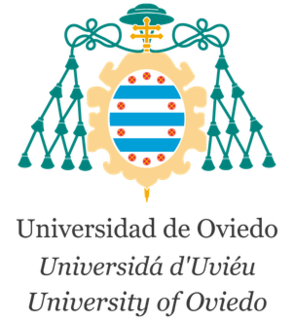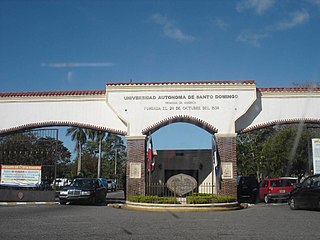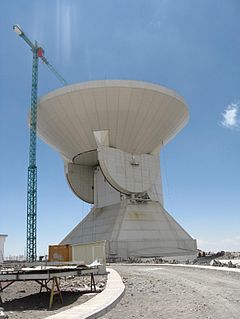
The National Autonomous University of Mexico is a public research university in Mexico. It is consistently ranked as one of the best universities in Latin America, where it's also the biggest in terms of enrollment. A portion of UNAM's main campus in Mexico City, known as Ciudad Universitaria, is a UNESCO World Heritage site that was designed by some of Mexico's best-known architects of the 20th century and hosted the 1968 Summer Olympic Games. Murals in the main campus were painted by some of the most recognized artists in Mexican history, such as Diego Rivera and David Alfaro Siqueiros. With acceptance rates usually below 10%, UNAM is also known for its competitive admission process. All Mexican Nobel laureates are either alumni or faculty of UNAM.

Club Universidad Nacional, A.C., commonly referred to as UNAM, is a professional football club based in Ciudad Universitaria of Mexico City, Mexico. The club competes in the Liga MX, the top division in the Mexican football league system. Founded in 1954, they play their home games at Estadio Olímpico Universitario.

The University of Oviedo is a public university in Asturias (Spain). It is the only university in the region. It has three campus and research centres, located in Oviedo, Gijón and Mieres.

The National University of Colombia is a public and national research university in Colombia, with general campuses in Bogotá, Medellín, Manizales and Palmira, and satellite campuses in Leticia, San Andrés (island), Arauca, Tumaco and La Paz, Cesar. It was established in 1867 by an act of the Congress of Colombia, and it is one of the largest universities in the country, with more than 53,000 students. It grants many academic degrees and offers 450 academic programmes, including 95 undergraduate degrees, 83 academic specializations, 40 medical specialties, 167 master's degrees, and 65 doctorates. Approximately 44,000 students are enrolled for an undergraduate degree and 8,000 for a postgraduate degree. It is also one of the few universities that employs post-doctorate fellows in the country.

The Universidad Autónoma de Santo Domingo (UASD) is the public university system in the Dominican Republic with its flagship campus in the Ciudad Universitaria neighborhood of Santo Domingo and with regional campuses in many cities of the Republic. It was founded by Jose Gabriel Garcia and Emiliano Tejera in 1866 as the Professional Institute, replacing the former Universidad Santo Tomás de Aquino, one of the first universities of the Western Hemisphere (Americas), which was founded unofficially by a Papal bull in 1538, officially by royal decree in 1558, and closed in 1822. It was later renamed University of Santo Domingo in 1914.
The National Prize for Arts and Sciences is awarded annually by the Government of Mexico in six categories. It is part of the Mexican Honours System and was established in 1945. The prize is a gold medal and 520,000 pesos.
The Instituto de Investigaciones en Matemáticas Aplicadas y en Sistemas, or IIMAS is the research institute of the UNAM in Mexico City which focuses on computer science, applied mathematics, and robotics and control engineering.

The National College is a Mexican honorary academy with a strictly limited membership created by presidential decree in 1943 in order to bring together the country's foremost artists and scientists, who are periodically invited to deliver lectures and seminars in their respective area of speciality. Membership is generally a lifelong commitment, although it could be forfeited under certain conditions. It should not be confused with El Colegio de México, a public institution of higher education and research.

UNAM'sSchool of Medicine is the medical school of the National Autonomous University of Mexico (UNAM), located at the university's main campus of Ciudad Universitaria. Established in 1553 as part of the Royal and Pontifical University of Mexico, it is one of the oldest medical schools in the Americas. The school has undergraduate and graduate studies departments. It does joint teaching with some other schools, e.g., the School of Science. It also has many grants involving UNAM's Engineering School, in areas such as smart and connected health. It is one of the most recognized schools in the university and in Mexico. The latest three rectors of the university, including the current one, are former deans from this school.

The School of Architecture at UNAM is one of the leading schools of architecture and design in Mexico. It offers undergraduate and postgraduate studies in architecture, landscape architecture, urbanism and industrial design.

The School of Engineering at the National Autonomous University of Mexico (UNAM) is the most prestigious engineering school in Latin America and one of the top engineering schools worldwide. At the undergraduate level, it offers thirteen majors and some graduate programs. In fall 2008, the school of engineering had over 10,900 undergraduate students and 1,115 graduate students and postdocs.

The Faculty of Sciences at the National Autonomous University of Mexico (UNAM) is the entity where natural and exact science-based majors are taught. It has both undergraduate and graduate studies, some of the former in joint teaching with other faculties, most commonly the Faculty of Engineering. The Faculty of Sciences is the most important science school in the country by the number of students and the quality of its research. Together with the research institutes that surround it, it is considered one of the biggest research complexes of the UNAM.

The history of science and technology in Mexico spans many years. Ancient Mexican civilizations developed mathematics, astronomy, and calendrics, and solved technological problems of water management for agriculture and flood control in Central Mexico. Following the Spanish conquest in 1521, New Spain was brought into the European sphere of science and technology. The Royal and Pontifical University of Mexico, established in 1551, was a hub of intellectual and religious development in colonial Mexico for over a century. During the Spanish American Enlightenment in Mexico, the colony made considerable progress in science, but following the war of independence and political instability in the early nineteenth century, progress stalled. During the late 19th century under the regime of Porfirio Díaz, the process of industrialization began in Mexico. Following the Mexican Revolution, a ten-year civil war, Mexico made significant progress in science and technology. During the 20th century, new universities, such as the National Polytechnical Institute, Monterrey Institute of Technology and research institutes, such as those at the National Autonomous University of Mexico, were established in Mexico.
Luis Enrique Bracamontes Gálvez was a Mexican politician and engineer. He was a member of the Institutional Revolutionary Party and Secretary of Public Works under President Luis Echeverria Álvarez.
Events in the year 1936 in Mexico.

José Florencio Fernández Santillán is a political science professor and researcher at Monterrey Institute of Technology and Higher Education, Mexico City. He and his work appear in academic and popular media in Mexico.

The School of Chemistry is one of the 27 academic institutions that are part of the National Autonomous University of Mexico (UNAM). The School carries out research activities in the fields of biochemistry, analytical chemistry, organic chemistry, physical chemistry, food chemistry, biotechnology, metallurgy, chemical engineering, pharmacy, inorganic chemistry, nuclear chemistry, theoretical chemistry and theoretical physics. The School is organized into 12 scientific departments and 4 units.
Carlos Graef Fernández was a Mexican physicist and mathematician. A graduate of the National Autonomous University of Mexico (UNAM) and the Massachusetts Institute of Technology (MIT), he was a founding member of the Mexican Mathematical Society and the Mexican Physical Society. He helped to establish the Tonantzintla Observatory and he later directed it. He received the National Prize for Arts and Sciences in 1970.












